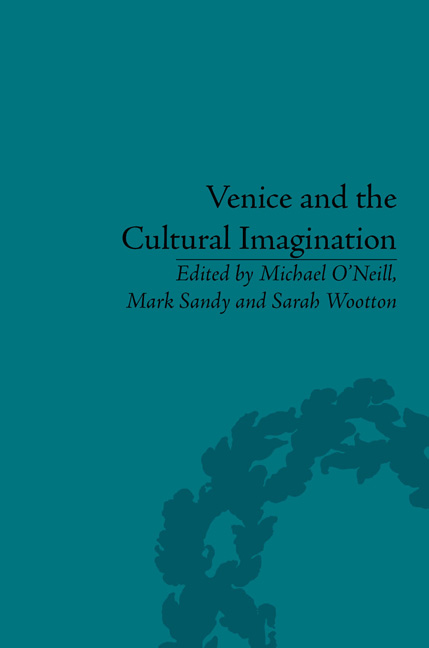Book contents
- Frontmatter
- CONTENTS
- Acknowledgements
- List of Figures
- Notes on Contributors
- Introduction
- 1 A ‘More Beloved Existence’: From Shakespeare's ‘Venice’ to Byron's Venice
- 2 Reimagining Venice and Visions of Decay in Wordsworth, the Shelleys and Thomas Mann
- 3 J. M. W. Turner and the ‘Floating City’
- 4 Venice and Opera: Tradition, Propaganda and Transformation
- 5 Venice, Dickens, Robert Browning and the Victorian Imagination
- 6 ‘The Lamp of Memory’: Ruskin and Venice
- 7 Edith Wharton's ‘Venetian Backgrounds’
- 8 Henry James's Venice and the Visual Arts
- 9 The Myth of Venice in the Decline of Eliot and Pound
- 10 Representations of Venice in Daphne du Maurier's Don't Look Now and Nicolas Roeg's Screen Adaptation
- Notes
- Select Bibliography
- Index
3 - J. M. W. Turner and the ‘Floating City’
- Frontmatter
- CONTENTS
- Acknowledgements
- List of Figures
- Notes on Contributors
- Introduction
- 1 A ‘More Beloved Existence’: From Shakespeare's ‘Venice’ to Byron's Venice
- 2 Reimagining Venice and Visions of Decay in Wordsworth, the Shelleys and Thomas Mann
- 3 J. M. W. Turner and the ‘Floating City’
- 4 Venice and Opera: Tradition, Propaganda and Transformation
- 5 Venice, Dickens, Robert Browning and the Victorian Imagination
- 6 ‘The Lamp of Memory’: Ruskin and Venice
- 7 Edith Wharton's ‘Venetian Backgrounds’
- 8 Henry James's Venice and the Visual Arts
- 9 The Myth of Venice in the Decline of Eliot and Pound
- 10 Representations of Venice in Daphne du Maurier's Don't Look Now and Nicolas Roeg's Screen Adaptation
- Notes
- Select Bibliography
- Index
Summary
For many people Venice is the place most closely associated with Turner. He made definitive contributions to the iconography of other cities, notably Oxford, Paris and Rome; of wildernesses such as the mountains of Snowdonia and the Alps; yet the vaporous luminosity of the Venetian lagoon, the fluid evanescence of the shadows on its crumbling palazzi and canals, seem uniquely fitted to his celebrated skills as a painter of light and colour. And it would appear that Turner himself felt something of the same as it were instinctive rapport. Yet knowing his creative psychology one must conclude that he found Venice above all a place, not so much of easy and cosy symbiosis, but one where he could stretch his abilities, teach himself more about his own expressive tools and language.
It is reasonable to suppose that a young artist will make every work he produces a learning exercise; but Turner's capacity to do that was remarkable. He was lucky: circumstances conspired to enable him to experience landscape – the principal subject of his creative endeavours – in progressively challenging forms throughout his youth. The conformation of the British Isles meant that a London boy would quite logically progress from the pastoral landscape of the south-east – England's ‘home farm’ – to the hills of South Wales and the Pennines, and from there to Snowdonia, and on to the Scottish Highlands.
- Type
- Chapter
- Information
- Venice and the Cultural Imagination'This Strange Dream upon the Water', pp. 43 - 58Publisher: Pickering & ChattoFirst published in: 2014



